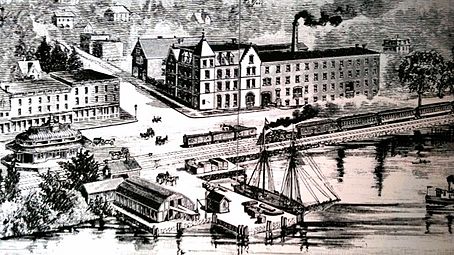Lord & Burnham
41°02′23″N 73°52′22″W / 41.039672°N 73.872715°W
 | |
| Industry | manufacturing |
|---|---|
| Founded | 1849 in Buffalo, New York |
| Founders | Frederick A. Lord and William Addison Burnham |
| Defunct | 1988 |
| Headquarters | |
Area served | USA |
| Products | Boilers, greenhouses, and conservatories |
Lord & Burnham was a noted American boiler and greenhouse manufacturer, and builders of major public conservatories in the United States.
History
The company began in 1849 when Frederick A. Lord, a carpenter, started building wood and glass greenhouses for neighbors in Buffalo, New York. It became Lord's full-time profession in 1856 as production moved to Syracuse, New York and then to Irvington, New York to be closer to his customers in the large Hudson River estates. In 1872 Lord's son-in-law William Addison Burnham joined the firm. Their first major commission came in the 1876 when California philanthropist James Lick hired the firm to create a 12,000-square-foot (1,100 m2) conservatory similar to that in Kew Gardens. Its parts were fabricated in New York and sailed to California. After Lick's death, it became the Golden Gate Park Conservatory of Flowers.
In 1881 the firm constructed the first steel-framed curvilinear greenhouse in the United States for railroad magnate Jay Gould, on a property now open as Lyndhurst. In 1883 the partnership incorporated as Lord's Horticultural Manufacturing Company, and in 1890 the name was changed to today's Lord & Burnham Company.
Beginning in 1894, the company purchased underwater property beyond the tracks and began filling in to create new land for an expansion. The expansion complex was completed by 1912, at which time the company employed 250 men.
The company used the property as additional factory space in the production process of their greenhouses.[1] By 1988, only about a dozen employees remained at the Irvington factory, and Lord and Burnham ceased to exist when the factory closed in that year.[2]
1989 Acquisition
Lord & Burnham's product line was acquired in 1989 by the Under Glass Manufacturing Co., which continues to manufacture Lord & Burnham greenhouses and solariums.[3] Lord & Burnham's historical records are archived at the New York Botanical Garden. The collection includes over 140,000 architectural plans for more than 7,000 glass structures
William Addison Burnham continued to make boilers and the company he founded, Burnham Commercial, continues to do so today.[4]
Conservatories
The company's early greenhouses were made of cypress and iron or steel. Although experimentation with aluminum began in 1932 with the United States Botanic Garden, commercial production was not economical until 1955.
Major Lord & Burnham conservatories include:
- Phipps Conservatory & Botanical Gardens, Schenley Park, Pittsburgh, 1892–1893
- Buffalo and Erie County Botanical Gardens, Buffalo, New York, 1895–1899
- New York Botanical Garden, 1899–1902
- Sonnenberg Gardens and Mansion State Historic Park, Canandaigua, New York, 1903–1915
- Reynolda Gardens, Wake Forest University, Winston-Salem, North Carolina 1912
- United States Botanic Garden, Washington, DC, 1933
- Volunteer Park Conservatory, Volunteer Park, Seattle, Washington, 1912
- Krohn Conservatory, Eden Park, Cincinnati, built 1933, restored by Lord & Burnham in 1966[5]
Gallery
-
The Lord & Burnham Building on the Irvington, New York waterfront in the 1800s
-
The building has now been converted into apartments, and a new home for the Irvington Public Library (2007)
See also
References
- ^ Lord & Burnham
- ^ Irvington Historical Society
- ^ "Lord & Burnham" on the Under Glass website
- ^ Burnham Commercial website
- ^ Bennett, Paul (Jul 1, 2000). The Garden Lover's Guide to the Midwest. Princeton Architectural Press. p. 35. Retrieved 2013-06-02.
External links
- Buffalo Gardens.com: "Crystal Palaces" — article on Lord & Burnham.
- Greenhouses in the United States
- Architects from Buffalo, New York
- Landscape design history of the United States
- Manufacturing companies based in New York
- Companies based in Buffalo, New York
- Design companies established in 1849
- Manufacturing companies established in 1849
- Manufacturing companies disestablished in 1988
- 1849 establishments in New York
- 1988 disestablishments in New York
- Defunct companies based in New York



